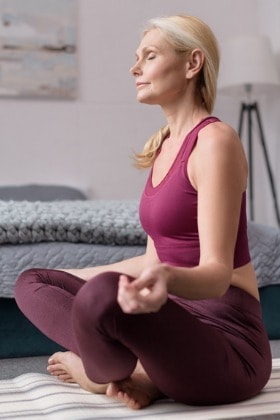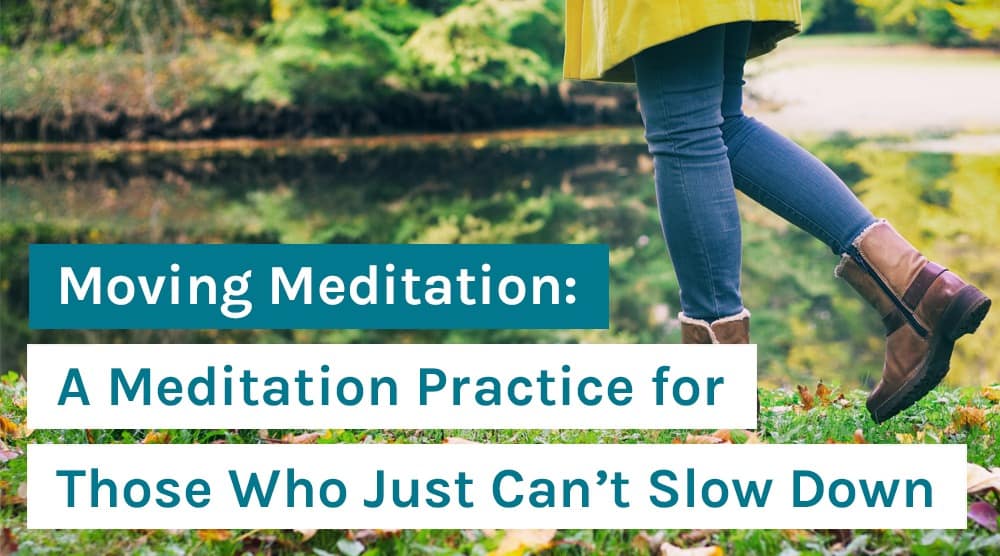Moving Meditation: A Meditation Practice for Those Who Just Can’t Slow Down
In a hurry? Click here to read the Article Summary...
Have you heard about all the numerous health benefits of meditation… but can’t seem to sit still long enough to actually meditate? If so, a moving meditation practice might be exactly what you’ve been seeking.
Sitting vs. Moving Meditation: What’s the Difference?

When practicing traditional sitting meditation, the goal is a little different than with moving meditation. In sitting meditation, you might have your attention on a mantra or on your breath. You’re generally aiming to quiet a busy mind by not engaging with your thoughts.
In a moving meditation, however, your body is moving while your attention is fully on whatever you might be experiencing at the moment. It’s taking the time to slow down and really use all of your senses to feel, hear, taste, smell, and see what you’re doing. In other words, mindfulness.
Mindfulness and moving meditation (which is a type of mindfulness practice) are increasingly popular in a hectic, fast-paced world where finding time to sit quietly and meditate might feel quite out of reach for many people.
The good news is that mindfulness offers a surprising number of health benefits including [1-3]:
- reduction of stress
- better clarity of mind
- improved memory
- feelings of compassion for self and others
- increased creativity
- better sleep
Movement Meditation and Quieting the Mind

The goal of moving meditation is not to have a goal or a destination! It’s simply to help you quiet your mind and to cultivate the ability not to get hooked into every thought that comes along.
While in the midst of a moving meditation, your mind will most likely stray. When that happens, just bring your mind back to what you’re doing and keenly focus on your senses – what you are touching, hearing, seeing, tasting, smelling. Just aim to be in the moment and fully appreciate each sensation.
This can have some far-reaching, positive benefits, including:
• Better cognitive function
• Decreased blood pressure
• Decreased incidence of depression
• Improved emotion regulation
If you practice mindfulness / moving meditation regularly you might just find that it can change your life!
How to Practice Mindfulness Meditation
Here is an example of how you can turn a walk (or even part of a walk) into a moving mindfulness meditation.

- Distance yourself from your thoughts and really be present and alive to this moment.
- Slow down just a little and let your breath be a little deeper. For instance, if your normal inhale and exhale are two seconds each, make them each three seconds.
- Pay close attention to each footfall. How does it feel when your foot strikes the ground? How do your feet feel in your shoes? Do your toes point forward or slightly outward? How does it feel when your weight shifts from one foot to the other? How does your body feel overall?
- What can you hear close by? What can you hear in the distance?
- What is the taste in your mouth?
- What can you smell?
- What can you see close by, and what can you see in the distance?
- Now, without getting overwhelmed, try to incorporate all of your senses at once. (i.e., Feel what you’re feeling, hear what you’re hearing, taste what you’re tasting, smell what you’re smelling, see what you’re seeing.)
This is how simple moving meditation can be. It’s all about taking yourself out of your head and really paying close attention to what’s happening in the here and now.
You are, for all intents and purposes, operating fully in the present. Not focusing on your daily worries, fears, and anxieties (as we are all prone to do), but on your senses – being fully alive to what is going on in the moment.
Good Times for Practicing Moving Meditation
There are numerous times of the day when you can easily practice moving meditation, with no one else the wiser. Remembering to do it is the only difficult part!

1. Folding, Ironing or Hanging Laundry on Clothesline
Nothing can be more potentially boring than laundry-related tasks. But tuning in and being mindful can make them a joy. Pay close attention to each thing you pick up; really feel its texture. Breathe. Use each of your senses to tune in to what you’re doing.
2. Food Preparation
At the end of a long day, who wants to cook? But by employing moving meditation, you can create your own zone of zen as you choose ingredients, prepare, and then cook them. Again, pay close attention to each item, really feel its texture, smell its aroma, etc.
3. Eating a Meal
Rather than zoning out in front of the television or scrolling on your phone, take the time to really taste each morsel of food. See it, smell it, taste it, feel the different textures in your mouth, and marvel at the miracle of how it arrived on your dinner plate.
This can really bring a new dimension to eating. Hear the music that you might play in the background, or the sound of your partner’s voice. Mealtime can be a time to really connect on a deeper level.

4. Washing Dishes
This can be yet another mindless, potentially boring job… unless you’re utilizing moving meditation. Employ all your senses and just focus on the one dish in your hand. If you become lost in thought, gently return to the task at hand.
Pay attention to smells, sounds, the temperature of the water, the weight of the dish in your hand, the miracle of indoor running water, and keeping your thoughts peaceful.
5. During Exercise
Taking a walk, running, swimming, gym workouts, yoga, qigong, etc. These are all an excellent time to practice moving meditation. Thoughts tend to stray more here, but rather than becoming enmeshed in them, just let them go.
Be in the here and now, and feel your body moving, the temperature of the air, a bird flying past, a squirrel running up a tree, the smell of the sun-warmed plants (or rain-soaked, depending on your day!).
In a class situation, employing moving meditation can initially be a bigger challenge (unless it’s yoga or qigong which are well-suited to moving meditation). But you will soon find that you can pay attention to the teacher, while at the same time focusing on your senses. By employing moving meditation with exercise, you can deepen your relationship with it – and yourself.
6. Taking a Shower or Bath
This is a great time for moving meditation because you are generally more relaxed at this time. It’s much easier to let your thoughts float away and to pay attention to your breathing, the feeling of the water against your skin, the smell of the soap, and so on.
7. Brushing Teeth
Take that two to three minutes to slow down and really feel the brush moving against your teeth and gums, to taste the toothpaste, to feel your body standing tall or leaning over the sink, to hear the water running as you rinse. Rather than letting this be a time to feel anxious about something, or to worry, let your mind be peaceful and calm.
8. Putting on Makeup, Fixing Hair, Shaving

Again, rather than using this time to plan out your day, try using it as a time to really feel the sensations of what you’re doing.
Smell the things you’re putting onto your skin, hear the sounds you are creating, see the changes you’re making, breathing through it all with intention.
9. Getting Dressed
Surprisingly, this can be another excellent (albeit brief) time for moving meditation. Pay close attention to how the fabric moves as you place it on your body. Can you smell the laundry soap you used to clean your clothes? Can you hear the rustle of the fabric as it moves? How does your skin feel in the article of clothing you just put on?
10. Mindless or Repetitive Work at the Office (like photocopying)
Another good time to practice moving meditation. You can still pay attention to what it is you’re doing, but also take a moment to slow down, and use all of your senses to calm your mind. This actually helps to bring more focus and clarity to the job at hand.
11. Listening to Music
A really good thing to do if you’re feeling restless, anxious, or depressed. Put on your headphones (if you have them), choose some favorite music and really listen closely. Really hear each instrument. This brings a whole new dimension to your music appreciation. At the same time, you can pay close attention to your other senses. Is your body moving in response to the music? Can you smell something nearby? What can you see around you?
By practicing moving meditation during the above-suggested times, you’re still being productive but you’re not getting hooked into negative thinking. Instead, you are mindfully doing whatever it is you’re doing, and being fully alive in the moment. This has a very calming effect on the nervous system, and that means less stress and disease.
12. While Driving
Another prime time to practice moving meditation is when you’re driving. Don’t worry – you won’t be closing your eyes or falling into a deep trance, so this is completely safe. It’s just a little different than other forms of moving meditation and can be an interesting experience.
Get into your car and take a deep breath and let it out. Do that again. Set your intention to arrive at your destination safely, and that everyone traveling on the roads with you arrives at their destination safely too.

Make sure the radio is turned off for this and put your phone away where you can’t see or hear it. Then, as discussed above, as you are driving along begin to employ your senses. Really feel your back against the seat of the car, and feel your hands on the steering wheel.
Notice what temperature it is in the car. Be totally aware of what you can hear, both close by and in the distance. Smell what you can smell. You are keenly observing everything that is around you with the utmost clarity. Really seeing the cars ahead of you and behind you, and any nearby pedestrians. If someone cuts you off, you forgive him/her and drive on. If any negative thinking happens, just let it go and bring your mind back to the moment.
This is the way we should be driving; not by getting so involved with our thoughts or what’s on the news on the radio, or what that driver up there just did that we arrive at our destination completely unaware of what transpired to get us there. It’s a beautiful practice of open awareness.
Mindfulness Can Enhance All Aspects of Life
As you can see, with a little practice and mindfulness you can turn almost any activity or chore into a moving meditation. The best part is there are no classes you need to attend, no apps to download, no fees to pay. All it takes is a willingness to explore a new approach to life and putting your attention on the here and now.
Better Focus… Crystal-Clear Thinking… a Razor-Sharp Memory… ALL Are Within Your REACH! Each and every bottle of our Organixx Brain Health 8 formula contains a total of 8 superstar ingredients, straight from the AMAZON rainforest.

 Sources:
Sources:
Article Summary
Mindfulness and moving meditation (which is a type of mindfulness practice) are increasingly popular in a hectic, fast-paced world.
Moving meditation is different from traditional sitting meditation. Your body is moving while your attention is fully on whatever you might be experiencing at the moment.
Some of the positive benefits of mindfulness and moving meditation include:
• Stress & anxiety reduction
• Better cognitive function
• Decreased blood pressure
• Improved immune function
• Decreased incidence of depression
• Improved emotion regulation
With a little practice and mindfulness you can turn almost any activity or chore into a moving meditation.





Moving Meditation- this is exactly what all of us should do and can do. Anywhere anytime. No excuses. No more boring chores! Thanks very much.
We're glad you liked this article, Diviah! It is good to know that this topic motivated you to be more mindful anywhere and anytime.
Thank you for your feedback and we wish you the best in your Moving Meditation practice!
This is EXACTLY what I needed! How do you know? Amazing how the universe drops this kind of pearl right in my lap at the perfect time.
Thank-you!!!!
That is amazing to hear, Dusty Blue! We are pleased to know that you found this article helpful and informative. Thank you for taking the time to read it and we wish you the best in your mindfulness practice!
thank you so much for the suggestions and ways to practice meditation which practically saves me every day b/c iam anxious and a bit obsessive/compulsive and the meditation calms me immediately but b/c im so active the moving meditation is a godsend i ll practice daily/ but realyy ocean and his colleagues are my heroes thanks
Hi Ellen,
Thank you for your positive feedback. We're so happy to hear that our article on Moving Meditation has really helped you.
We appreciate you being part of the Organixx community and wish you all the best on your wellness journey!!
Hi.
If anyone is interested in what is beyond the mind and the 5 senses I would advice to be willing to sense and perceive those very subtle things that comes into your awareness that you might call fantasies or dreams or bullshit. What if it does not come into your mind? What if it is information that is available to you as a knowing or similar?
These are the things like :
1. wow, what is that thing behind me, and when you turn around you don't think there is anything, or
2. I think I saw an animal over there and when other people look they don't see anything at all, but deep down you know what you saw, but previously because no other of your friends saw it you believe more in their story than in your on knowing, or
3. you look out in front of you and you see a very beautiful aura around another person and no other person sees it, or
4. you hear something 2 kilometres away and no other person heard it, and you believe that because no one heard it that it was just your imagination,
etc... well you get the picture I hope.
What if your senses are much more than the normal 5 senses?
What if if you combine more than 2 senses and include your knowing, what would you become aware of then?
Or what if you include all your other 1 million senses, what would you sense then?
And what else is possible if you destroy all the previous "you cannot know that" or "there is nothing there, it is just your imagination" or "you are just useless, what can you possibly be or do that anyone would wanna pay or have"?
What would happen if you never ever again let yourself be affected by other peoples points of view or judgments?
All the thoughts, feelings, emotions, judgments, decisions, considerations and or conclusions that my long comment is bringing up or down, would you be willing to destroy or uncreate all of that, or begin to let yourself free from a part or all of those, please, please, please?
And good luck with these exercises. And thank you for this article!!!